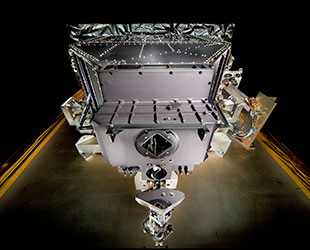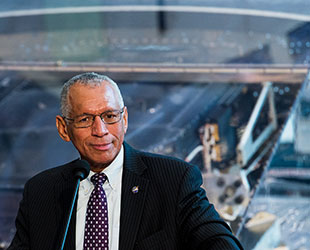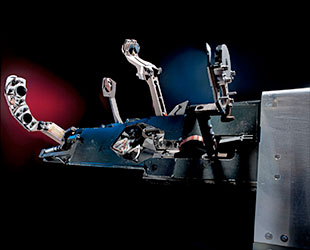April 24, 2014 — Almost a quarter of a century after the Hubble Space Telescope was launched into orbit, two of the observatory's most famous instruments have landed in a new exhibit at the Smithsonian's National Air and Space Museum.
On Wednesday (April 23), the Washington, D.C. institution debuted "Repairing Hubble" in its Space Hall. The display, which is positioned under the full-size structural dynamic test mockup for the Hubble, features the Corrective Optics Space Telescope Axial Replacement (COSTAR) and the Wide Field and Planetary Camera 2 (WFPC2) instruments that were returned to Earth by the space shuttle after the final Hubble servicing mission in 2009.
"The achievements associated with WFPC2 and COSTAR date from 1993, when repairs accomplished on the first servicing mission enabled the telescope to function in an optimum way," J.R. "Jack" Dailey, director of the National Air and Space Museum, said at a reception marking the exhibit opening Wednesday. "The exhibition tells the story of the Hubble by tracing the brilliant technology it required and showing the human skill and courage that led to its long and successful life."

Installed on the Hubble Space Telescope in 1993 and returned to Earth in 2009, the Wide Field Planetary Camera 2 (WFPC2), now exhibited as a part of "Repairing Hubble" at the National Air and Space Museum in Washington, D.C., demonstrated the capability of astronomical imaging from space. (Smithsonian/Eric Long) |
"This exhibition is in anticipation of the 25th anniversary of the operational life of Hubble," he stated. "The display will enable millions of people to understand how the telescope has enriched our understanding of the universe."
Soon after the Hubble Space Telescope was deployed into orbit by the shuttle Discovery on April 25, 1990, scientists discovered the telescope's primary mirror had a flaw called "spherical aberration." The mirror's outer edge was ground too flat by a depth roughly equal to 1/50th the thickness of a human hair. Its images were fuzzy because some of the light from the objects being studied was being scattered.
After the amount of aberration was understood, scientists and engineers developed WFPC2 and COSTAR.
COSTAR deployed corrective optics ("contact lenses") in front of three of Hubble's first generation instruments but it could not correct for the vision of the Wide Field/Planetary Camera. So, a replacement instrument, which was already in work as an upgrade, was hastily completed as WFPC2.
WFPC2 had its own corrective optics to compensate for the scattered light from the primary mirror. This allowed it to record razor-sharp images of celestial objects for more than 15 years. One of its landmark observations was the 1995 "Hubble Deep Field" that captured the light of 4,000 galaxies stretching 12 billion years back into time.

NASA Administrator Charles Bolden, who was pilot of the shuttle mission that launched the Hubble Space Telescope on April 24, 1990, is seen backdropped by the WFPC2 instrument at the debut of the "Repairing Hubble" exhibit. (NASA/Joel Kowsky) |
"COSTAR fixed Hubble's eyesight and the WFPC, and its 48 filters, allowed scientists to study precise wavelengths of light," Charles Bolden, NASA Administrator and pilot of the mission that deployed the Hubble, said. "Its postage-stamp-sized circuitry recorded the first light from some of the most massive phenomena we've ever comprehended."
"I am proud to have had a part in Hubble's legacy and very pleased today that the millions of visitors to the Air and Space Museum will be able to see the actual space-flown instruments that have peered across the galaxy at some of the most amazing cosmic phenomena ever witnessed," Bolden added.
The WFPC2 and COSTAR instruments were donated by NASA to the Smithsonian in November 2009, six months after they returned from orbit by the STS-125 crew on the space shuttle Atlantis. After a brief initial exhibition at the National Air and Space Museum, they travelled to the Jet Propulsion Laboratory (JPL) in California and other venues before returning in 2010 to go on permanent public display in Washington.
In addition to the instruments, "Repairing Hubble" features a selection of the images that the telescope captured as a result of being outfitted with the COSTAR and WFPC2.

The COSTAR instrument, which corrected for flaw in the primary mirror of the Hubble Space Telescope, is now on display as part of the "Repairing Hubble" exhibition. (Smithsonian/Eric Long) |
"We have to remind kids when we bring them here that all those pictures, many of them came from this camera and other instruments like it," Bolden said. "So when they look at [WFPC2], it helps them understand that it is more than just a box. It is an incredible instrument."
"All told," said former WFPC2 principal investigator John Trauger, "this object orbited the Earth 85,000 times, taken something on the order of 135,000 images, supported tens of thousands of scientific papers, and it is kind of a joy to see that it has worked out so well."
"Repairing Hubble" was supported by NASA, including the Goddard Space Flight Center in Greenbelt, Maryland, and the Space Telescope Science Institute in Baltimore. The exhibit was designed and constructed by the National Air and Space Museum's staff.
"Enjoy it," John Grunsfeld, NASA associate administrator for the Science Mission Directorate and an astronaut who flew on three of the servicing missions to Hubble. "I know millions of people visiting the museum will come by and will be stimulated by the images and the exhibit."
